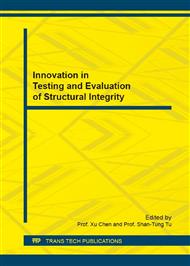[1]
A.M. Leach, S.R. Daniewicz, J.C. NewmanJr, A new constraint based fracture criterion for surface cracks, Eng. Fract. Mech. 74 (2007) 1233-1242.
DOI: 10.1016/j.engfracmech.2006.07.011
Google Scholar
[2]
G.R. Irwin, Fracture dynamics, in: fracturing of metals, AsM Publications, 1948, pp.147-166.
Google Scholar
[3]
J.R. Rice, A path independent integral and approximate analysis of strain concentration by notches and cracks, J. Appl. Mech. 35 (1968) 379-386.
DOI: 10.1115/1.3601206
Google Scholar
[4]
R.H. Dodds, C.F. Shih, T.L. Anderson, Continuum and micromechanics treatment of constraint in fracture, Int. J. Fatigue. 64 (1993) 101-133.
DOI: 10.1007/bf00016693
Google Scholar
[5]
S.G. Larsson, A.J. Carlsson, Influence of non-singular stress terms and specimen geometry on small-scale yielding at crack tips in elastic-plastic material, J. Mech. Phys. Solids. 21 (1973) 263-277.
DOI: 10.1016/0022-5096(73)90024-0
Google Scholar
[6]
N.P. O'Dowd, C.F. Shih, Family of crack-tip fields characterized by a triaxiality parameter-I: Structure of fields, J. Mech. Phys. Solids. 39 (1991) 989-1015.
DOI: 10.1016/0022-5096(91)90049-t
Google Scholar
[7]
Y.J. Chao, S. Yang, M.A. Sutton, On the fracture of solids characterized by one or two parameters: theory and practice, J. Mech. Phys. Solids. 42 (1994) 629-647.
DOI: 10.1016/0022-5096(94)90055-8
Google Scholar
[8]
W.L. Guo, Elastoplastic three dimensional crack border field-I: Singular structure of the field, Engng. Fract. Mech. 46 (1993a) 93-104.
Google Scholar
[9]
W.L. Guo, Elastoplastic three dimensional crack border field-II: Asymptotic solution for the field, Engng. Fract. Mech. 46 (1993b) 105-113.
DOI: 10.1016/0013-7944(93)90307-e
Google Scholar
[10]
W.L. Guo, Elastoplastic three dimensional crack border field-III: Fracture parameters, Engng. Fract. Mech. 51 (1995) 51-71.
Google Scholar
[11]
J.H. Zhao, W.L. Guo, C.M. She, The in-plane and out-of plane stress constraint factors and K-T-Tz description of stress field near the border of a semielliptical surface crack, Int. J. Fatigue. 29 (2007) 435-443.
DOI: 10.1016/j.ijfatigue.2006.05.005
Google Scholar
[12]
J.H. Zhao, Three-parameter approach for elastic-plastic stress field of an embedded elliptical crack, Engng. Fract. Mech. 76 (2009) 2429-2444.
DOI: 10.1016/j.engfracmech.2009.06.013
Google Scholar
[13]
M.C. Burstow, I.C. Howard, R.A. Ainsworth, The influence of constraint on crack tip stress fields in strength mismatched welded joints, J. Mech. Phys. Solids. 46 (1998) 845-872.
DOI: 10.1016/s0022-5096(97)00098-7
Google Scholar
[14]
C. Betegon, I. Penuelas, A constraint based parameter for quantifying the crack tip stress fields in welded joints, Engng. Fract. Mech. 73 (2006) 1865-1877.
DOI: 10.1016/j.engfracmech.2006.02.012
Google Scholar
[15]
T.L. Anderson, R.H. Dodds, Specimen size requirements for fracture toughness testing in the transition region, J. Test. Eval. 19 (1991) 123-134.
DOI: 10.1520/jte12544j
Google Scholar
[16]
M. Mostafavi, D.J. Smith, M.J. Pavier, A micromechanical fracture criterion accounting for in-plane and out-of-plane constraint, Comp. Mater. Sci. 50 (2011) 2759-2770.
DOI: 10.1016/j.commatsci.2011.04.023
Google Scholar
[17]
J. Yang, G.Z. Wang, F.Z. Xuan, S.T. Tu, Unified characterisation of in-plane and out-of-plane constraint based on crack-tip equivalent plastic strain, Fatigue Fract. Engng. Mater. Struct. 36 (2012) 504-514.
DOI: 10.1111/ffe.12019
Google Scholar
[18]
J. Yang, G.Z. Wang, F.Z. Xuan, S.T. Tu, Unified correlation of in-plane and out-of-plane constraint with fracture toughness, Fatigue Fract. Engng. Mater. Struct. 37 (2014) 132-145.
DOI: 10.1111/ffe.12094
Google Scholar


